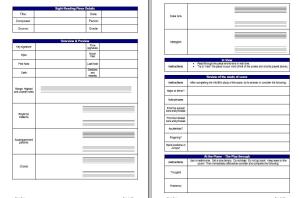An Extreme Sight-Reading Pre-study Checklist!

We are used to the idea of “Extreme Sports” so how about an “Extreme Sight-Reading Pre-study” Checklist? 😉
Lately I’ve formalised my sight-reading practice into two tasks: firstly an away from the piano pre-study task of around 20 minutes. Secondly the play through at the piano.
The aim of the pre-study of the score is to really suck out as much information as possible. This is completed prior to sitting down and playing through the piece at the piano. I think that this skill is one aspect of what good sight-readers do intuitively and quickly.
To help this process, I started writing a check list of things that I must look for in the score during the pre-study. In recent weeks this has now evolved into the “Sight-Reading Pre-study Checklist” shown here and which has gone through several cycles of revision.
My experience using this has been very positive in that it helps to grasp and assimilate the score and keep focus during the pre-study of the piece. What has also been an eye-opener, is writing out the notes, staffs, scales runs, chords and so forth on the blank staffs I’ve put in the checklist. This greatly helps with the decoding of for example, the highest or lowest notes on each staff and those in particular with lots of ledger lines.
I’m finding it’s currently taking around about 20 minutes to go through a simple Grade 2 piece (ABRSM). I’ve also noticed that the number of problems encountered during the “real” play through at the piano have reduced (and so I have dropped the ‘at the piano’ study task to 3 minutes). Any problems are noted down afterwards. The completed forms for each sight-read piece are available for subsequent review.
Further details and a link to a PDF of the checklist can be found in the full article. The checklist is in an evolutionary state and your thoughts, ideas and comments are most welcome!
You can find a copy of the check list here… Sight Reading Checklist
The checklist is broken down into sections for the Overview & Preview, Inview, Play Through and final Review. Away from the piano and with the score open and propped up, I start completing the pre-study check list.
I fill it out long hand as I find this always helps me understand things. First of all, I note down the title of the piece, reference, the composers name, the source of the score.
OVERVIEW & PREVIEW
The study of the score itself begins I quickly scan the score for: key signature, time signature, tempo, cleffs of the staffs, first note, last note, mood, feel, and sections and repeat markings.
Then I identify the lowest and highest notes in each staff, rhythmic patterns, left hand accompaniment patterns, chords, scales runs and arpeggios/broken chords. Then I write notes about these and copy the notes out on the blank staffs provided in the checklist. This aspect of completing the checklist seems to have been very beneficial.
IN VIEW
Once the Overview and Preview is complete, I then read through the score end-to-end slowly in real time. I try to mentally rehearse playing through the piece for real. I also try to “hear” the piece in my “minds ear”.
REVIEW OF SCORE
Now I complete the pre-play through aspects of the checklist by noting thoughts on major or minor, easiest bars and phrases, the hardest bars and phrases, whether there’s accidentals (what they were), and possible changes or tricky hand positions and fingering.
PLAY THROUGH
So having completed the pre-study of the score, I immediately go to the piano and play through the piece.
REVIEW
Finally! Immediately after the play through I complete a brief review of thoughts about the piece and problems encountered.

I’m so glad to see people with an interest in learning to sight read well!
If you haven’t read it already, I highly recommend reading “Piano: Guided Sight Reading” by Leonhard Deutsch. He also has some out of print music books titled “For Sight Reading” which surface on Amazon and Ebay occasionally which are really great material if you’re not at a point where your sight reading Haydn and Mozart Sonatas. Book 1 is especially good for beginners as the pieces are short but challenging, in many different keys, and have the difficulties evenly distributed between both hands which is excellent preparation for reading Bach, which is daunting for most people.
Best of luck!